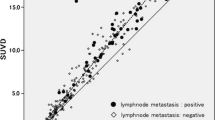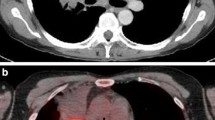Abstract
Purpose
The purpose of this study was to evaluate the impact of [18F]fluorodeoxy-d-glucose positron emission tomography (FDG-PET) on the primary staging of patients with small-cell lung cancer (SCLC).
Methods
FDG-PET was performed in 120 consecutive patients with SCLC during primary staging. In addition, brain examinations with both FDG-PET and cranial magnetic resonance imaging (MRI) or computed tomography (CT) were performed in 91 patients. Results of FDG-PET were compared with those of conventional staging procedures. FDG-PET detected markedly increased FDG uptake in the primary tumours of all 120 patients (sensitivity 100%).
Results
Complete agreement between FDG-PET results and other staging procedures was observed in 75 patients. Differences occurred in 45 patients at 65 sites. In 47 sites the FDG-PET results were proven to be correct, and in ten, incorrect. In the remaining eight sites, the discrepancies could not be clarified. In 14/120 patients, FDG-PET caused a stage migration, correctly upstaging ten patients to extensive disease and downstaging three patients by not confirming metastases of the adrenal glands suspected on the basis of CT. Only 1/120 patients was incorrectly staged by FDG-PET, owing to failure to detect brain metastases. In all cases the stage migration led to a significant change in the treatment protocol. Sensitivity of FDG-PET was significantly superior to that of CT in the detection of extrathoracic lymph node involvement (100% vs 70%, specificity 98% vs 94%) and distant metastases except to the brain (98% vs 83%, specificity 92% vs 79%). However, FDG-PET was significantly less sensitive than cranial MRI/CT in the detection of brain metastases (46% vs 100%, specificity 97% vs 100%).
Conclusion
The introduction of FDG-PET in the diagnostic evaluation of SCLC will improve the staging results and affect patient management, and may reduce the number of tests and invasive procedures.


Similar content being viewed by others
References
Jemal A, Taylor Murray AS, Ghafoor A, Ward E, Thun MJ. Cancer statistics. CA Cancer J Clin 2003;53:5–26.
Payne D, Naruke T. Lung cancer. In: Pollock RE, ed. Manual of clinical oncology, 7th edn. New York: Wiley; 1999:385–405.
Pasemans M, Sculier JP, Lecombe J, et al. Prognostic factors for patients with small cell lung carcinoma. Cancer 2000;89:523–33.
Simon GR, Wagner H. Small cell lung cancer. Chest 2003;123(Suppl):259S–271S.
Szczesny TJ, Szczesny A, Shepherd FA, et al. Surgical treatment of small cell lung cancer. Semin Oncol 2003;30:47–56.
Mountain CF. Revision in the international system for staging lung cancer. Chest 1997;111:1710–7.
Richardson GE, Daniel CI. Staging of small cell lung cancer. In: Carney DN, ed. Lung cancer. London: Arnold; 1995:114–21.
Darling GE. Staging of the patient with small cell lung cancer. Chest Surg Clin North Am 1997;7:81–94.
Warburg O, Posener K, Negelein E VIII. The metabolism of cancer cells. Biochem Zool 1924;152:129–69.
Gould MK, Maclean CC, Kuschner WG, et al. Accuracy of positron emission tomography for diagnosis of pulmonary nodules and mass lesions: a meta-analysis. J Am Med Assoc 2001;285:914–24.
Dwamena BA, Sonnad SS, Angobaldo JO, et al. Metastases from non-small cell lung cancer: mediastinal staging in the 1990s—meta-analytic comparison of PET and CT. Radiology 1999;213:530–6.
Marom EM, McAdams HP, Erasmus JJ, et al. Staging non-small cell lung cancer with whole-body PET. Radiology 1999;212:803–9.
Pieterman RM, Van Putten JWG, Meuzelaar JJ, et al. Preoperative staging of non-small cell lung cancer with positron emission tomography. N Engl J Med 2000;393:254–61.
Ahuja V, Coleman RE, Herndon J, et al. The prognostic significance of fluorodeoxyglucose positron emission tomography imaging for patients with nonsmall cell lung carcinoma. Cancer 1998;83:918–24.
Schumacher T, Brink I, Mix M, et al. FDG-PET imaging for the staging and follow-up of small cell lung cancer. Eur J Nucl Med 2001;28:483–8.
Pandit N, Gonen M, Krug L, et al. Prognostic value of [18F]FDG-PET imaging in small cell lung cancer. Eur J Nucl Med Mol Imaging 2003;30:78–84.
Zhao DS, Valdivia AY, Y Li, Blaufox MD. 18F-fluorodeoxyglucose positron emission tomography in small cell lung cancer. Semin Nucl Med 2002;32:272–5.
Hauber HP, Bohuslavizki KH, Lund CH, et al. Positron emission tomography in the staging of small cell lung cancer—a preliminary study. Chest 2001;119:950–4.
Chin R, McCain TW, Miller AA, et al. Whole body FDG-PET for the evaluation and staging of small cell lung cancer: a preliminary study. Lung Cancer 2002;37:1–6.
Shen YY, Shiau YC, Wang JJ, et al. Whole-body 18F-2-deoxyglucose positron emission tomography in primary staging small cell lung cancer. Anticancer Res 2002;22:1257–64.
Kamel EM, Zwahlen D, Wyss MT, Stumpe K, Schulthess GK, Steinert HC. Whole-body 18F-FDG PET improves the management of patients with small cell lung cancer. J Nucl Med 2003;44:1911–7.
Hamacher K, Coenen HH, Stöcklin G. Efficient stereospecific synthesis of no-carrier-added 2-[18F]-fluoro-d-glucose using aminopolyether supported nucleophilic substitution. J Nucl Med 1986;27:235–8.
Hudson HM, Larkin RS. Accelerated image reconstruction using ordered subsets of projection data. IEEE Trans Med Imaging 1982;13:601–9.
Mix M, Nitzsche EU. PISAC. A post-injection method for segmented attenuation correction in whole body PET. J Nucl Med 1999;40:297P [abstract].
Weiss C. Basiswissen Medizinische Statistik, 2nd edn. Berlin Heidelberg New York: Springer; 2001:249–51.
Imdahl A, Jenkner S, Brink I, et al. Validation of FDG positron emission tomography for differentiation of unknown pulmonary lesions. Eur J Cardiothorac Surg 2001;20:324–9.
Boland GW, Goldberg MA, Lee MJ, et al. Indeterminate adrenal mass in patients with cancer: evaluation at PET with 2-[F-18]-fluoro-2-deoxy-d-glucose. Radiology 1995;194:131–4.
Erasmus JJ, Patz EF Jr, McAdams HP, et al. Evaluation of adrenal masses in patients with bronchogenic carcinoma using 18F-fluorodeoxyglucose positron emission tomography. Am J Roentgenol 1997;168:1357–60.
Schumacher T, Brink I, Moser E, et al. Imaging of an adrenal cortex carcinoma and its metastasis with FDG-PET. Nuklearmedizin 1999;38:124–6.
Bury T, Barreto A, Daenen F, et al. Fluorine-18 deoxyglucose positron emission tomography for the detection of bone metastases in patients with non-small cell lung cancer. Eur J Nucl Med 1998;25:1244–7.
Cook GJ, Fogelman I. The role of positron emission tomography in the management of bone metastases. Cancer 2000;88:2927–33.
Coleman RE. PET in lung cancer staging. Q J Nucl Med 2001;45:231–4.
Jager PL, Vaalburg W, Pruim J, et al. Radiolabeled amino acids: basic aspects and clinical applications in oncology. J Nucl Med 2001;42:432–45.
Acknowledgements
The authors thank the “German Cancer Foundation” for their financial support of this study (#70-2594-Schu I). Furthermore, we are indebted to Claudia Santini-Böttcher and Harald Dietsche for their technical assistance and to Ursula Sahm, PhD, Kenneth Stålmo and Bernd Morasch for producing the radioisotope and radiopharmaceutical.
Author information
Authors and Affiliations
Corresponding author
Rights and permissions
About this article
Cite this article
Brink, I., Schumacher, T., Mix, M. et al. Impact of [18F]FDG-PET on the primary staging of small-cell lung cancer. Eur J Nucl Med Mol Imaging 31, 1614–1620 (2004). https://doi.org/10.1007/s00259-004-1606-x
Received:
Accepted:
Published:
Issue Date:
DOI: https://doi.org/10.1007/s00259-004-1606-x




